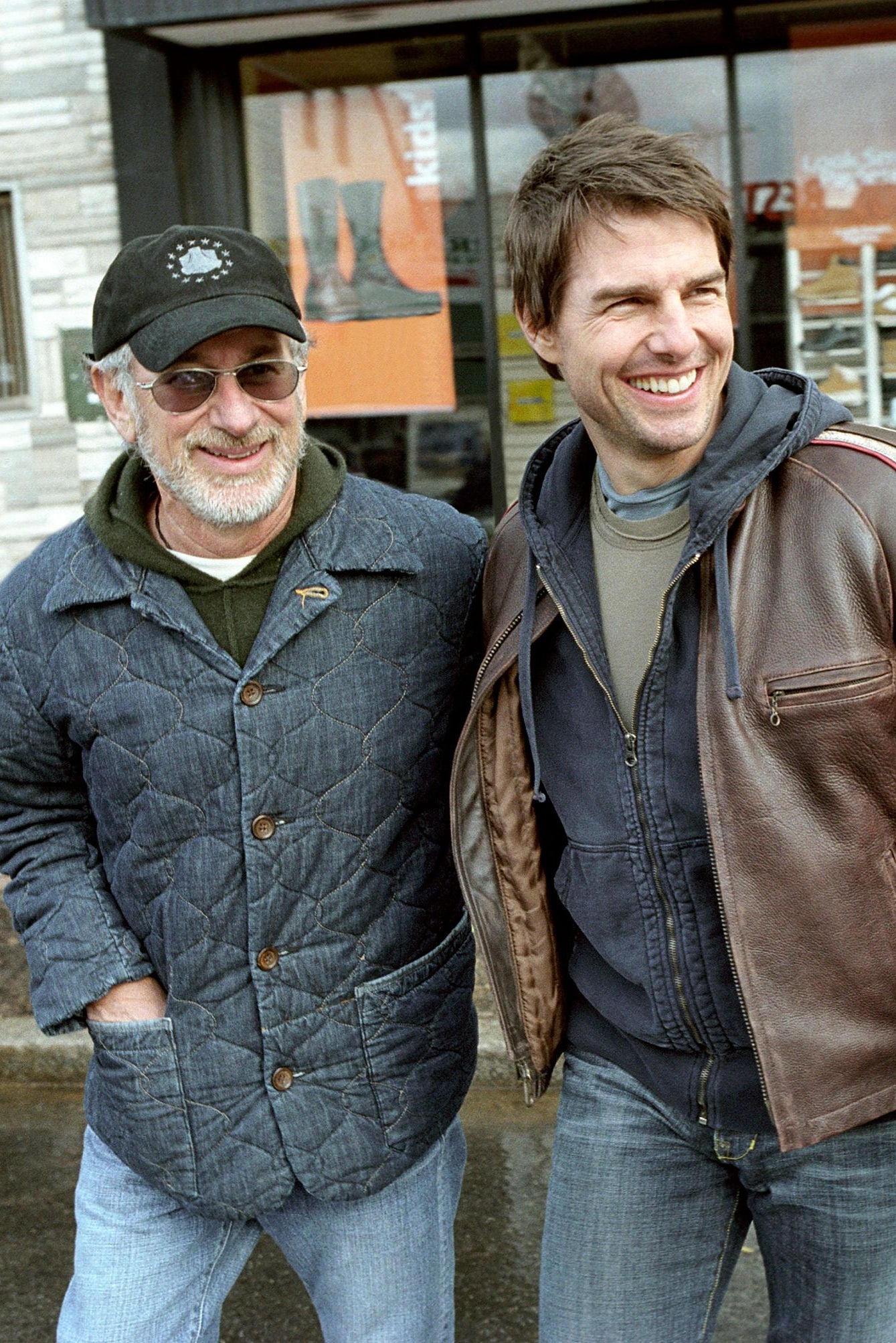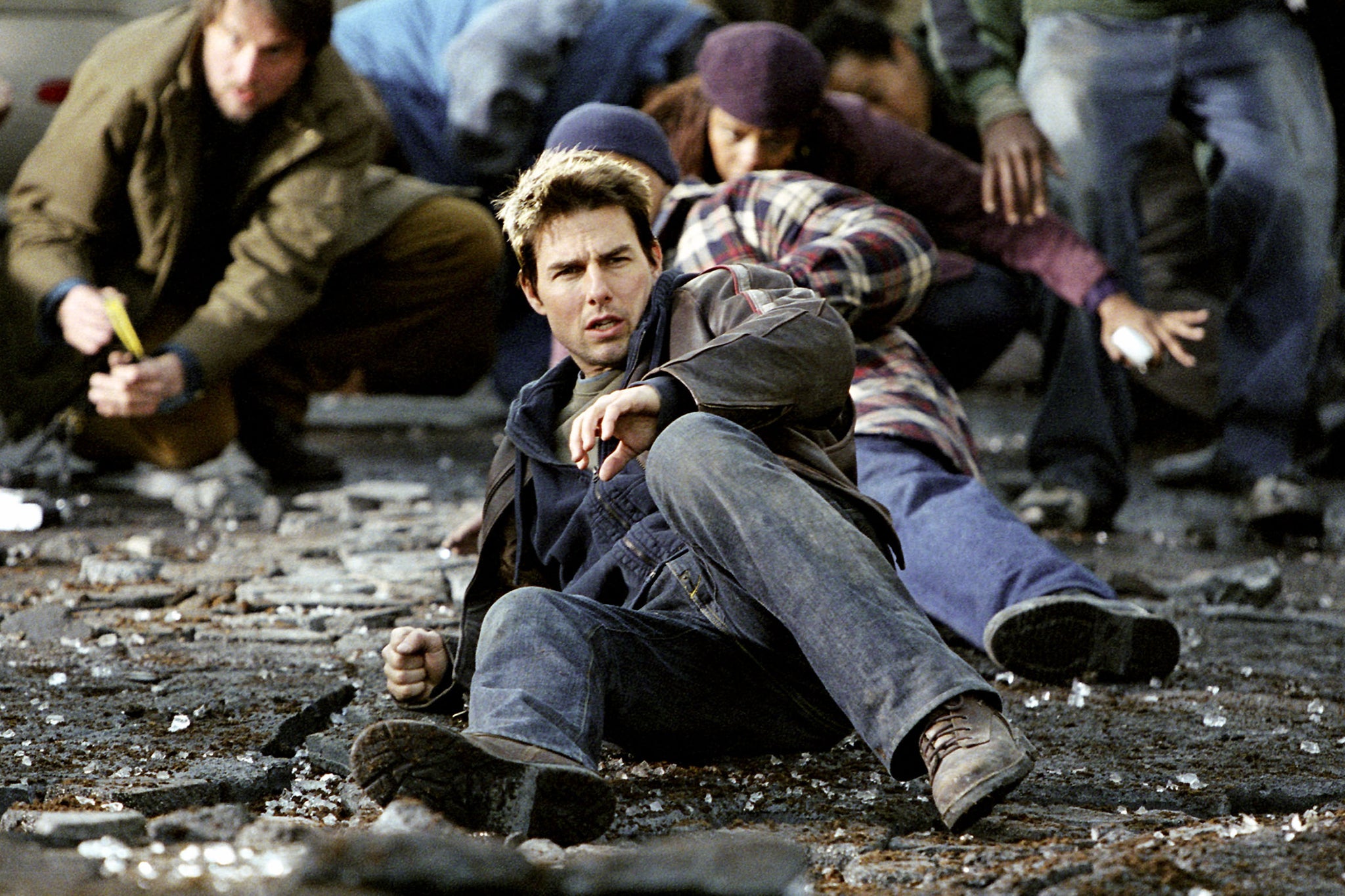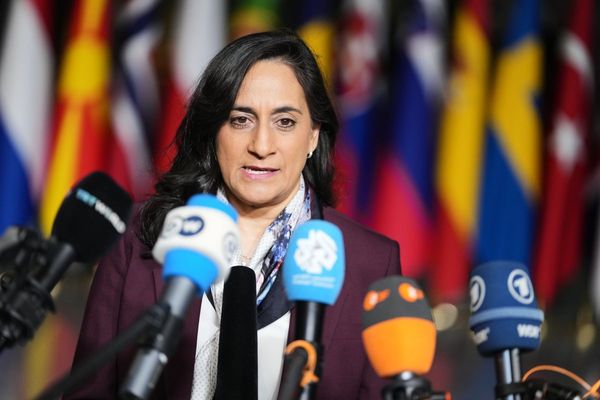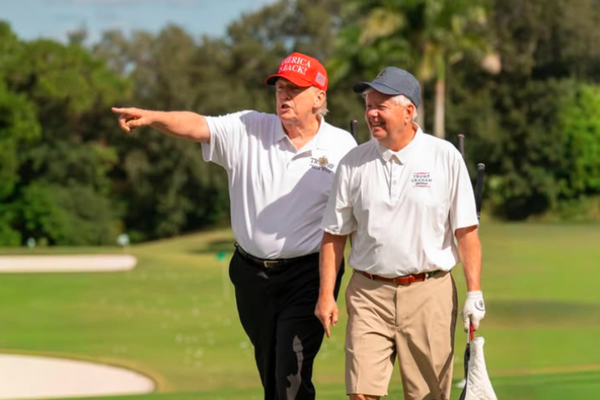The threat had come from within; from “right beneath our goddamn feet”, as Tim Robbins’s paranoid patriot Harlan Ogilvy would put it. Twenty years ago this week, Steven Spielberg’s War of the Worlds opened in British cinemas, offering us a big-budget replay of a trauma from which many of us were still recovering. The film wasn’t subtle in its nods to 9/11. After an opening shot that lingers on the Manhattan skyline, a deadly attack unfolds, glimpsed at one point through a grainy home camcorder. Citizens sprint from collapsing buildings, a church being one of the first structures to fall (September 11 was, after all, the first strike in what both sides would frame as a holy war).
Tom Cruise, playing divorced dad Ray, soon finds his face turned white from clouds of dust, echoing a famous photo of Marcy Borders, the New York legal assistant whose ghostly appearance after the towers fell resulted in one of that day’s defining images. And perhaps most notably of all, these terrorists didn’t launch their plot from afar, as is usually the case in alien invasion movies. Like the 19 al-Qaeda operatives who took control of planes on 9/11 – all of whom had been living in America, a sleeper cell waiting to strike – this destruction was wrought from upon US soil.
Two decades on, it’s easy to gloss over the echoes of 9/11 in Spielberg’s 2005 adaptation of HG Wells’s classic novel. After all, we’re now living in a time of superhero cinema domination: what are those movies forged in, if not the iconography of that day? Toppling skyscrapers, plumes of smoke, rubble-strewn streets. War of the Worlds’ 9/11-isms, by comparison, might not seem that remarkable to someone watching the film for the first time in 2025.
But make no mistake, Spielberg’s movie is one of the ultimate pieces of pop culture born of September 11. “I’d even suggest that it’s a key film in the evolution of how America processed [that day],” says Terrence McSweeney, senior lecturer in film and television studies at Southampton Solent University and the editor of a book of essays titled American Cinema in the Shadow of 9/11. He argues that, in War of the Worlds’ acknowledgement of the horrors of that bright Tuesday morning in September, America found much-needed catharsis.
More than half a billion dollars’ worth of catharsis, to be precise. Spielberg’s summer blockbuster was a commercial smash, exceeding the box-office takings of Christopher Nolan’s Batman Begins, released a few weeks prior. It had been a long road to this tale of mankind versus Martians for the director, as War of the Worlds executive producer Damian Collier explains. Back in the 1970s, Jeff Wayne – creator of the famous rock-opera version of Wells’s book, and Collier’s long-time business partner – “sent a copy of the album to Spielberg with the hope that he’d turn it into a movie,” explains Collier. “Spielberg sent a letter back saying: ‘I’ve received your album and I found it absolutely incredible. But my schedule for 1981 to 1982 is far too crammed to take on a movie of this size.’ It’s quite an interesting kind of artifact, that letter, because it was sort of prophetic. Steven of course would end up making War of the Worlds. Just in his own way… when the time was right.”
The right time was a troubled time. Spielberg is thought to have been in Los Angeles working on the edit for his Philip K Dick adaptation Minority Report when attacks on America’s eastern seaboard claimed 2,977 lives. One image from that day stuck with him: “Everybody in Manhattan fleeing across the George Washington Bridge,” he told a press conference in 2005. The sight of “Americans fleeing for their lives, being attacked for no reason, having no idea why they’re being attacked and who is attacking them” would form the basis for his movie.
It set a template that the majority of alien invasion narratives were to adopt throughout the rest of the decade and beyond
“There has been a conscious emotional shift in this country,” Spielberg explained further, in a later interview with USA Today. The aftermath of the attacks saw warm, comforting entertainment – ideally with a streak of patriotism – become the de facto form of media in US homes, as Americans sought distraction from terror. Spielberg’s movie, though, would press into the bruise, with imagery that confronted that painful memory.
A crashed plane fuselage, evocative of the United 93 flight that came down in Somerset County, Pennsylvania. Walls of photos of missing loved ones. Shots of distraught, shell-shocked Americans crossing a bridge, just like Spielberg had seen on the George Washington. These weren’t just flourishes added to a film to give it real-world relevance; they were the film. Would Spielberg have made War of the Worlds without 9/11, one reporter for German magazine Die Spiegel asked in 2005? “Probably not,” came his blunt reply.
The director had made films before that “repackaged cultural trauma for the consumption of mainstream audiences”, McSweeney points out, “whether it’s the Holocaust in Schindler’s List, the D-Day landings in Saving Private Ryan or slavery in Amistad”. Never before, though, had he tackled a trauma as recent as this one, and the jury was out among America’s critical community as to whether it had arrived too soon. Stephanie Zacharek – now chief film critic at Time Magazine, then a writer for Salon – complained that Spielberg had lost “his sense of decency” as well as his “faith in the decency of his audience”. Timothy Noah, meanwhile, let his feelings be known in a piece for Slate reminding filmmakers that “9/11 was not a summer movie” to be mined for ideas. War of the Worlds, he wrote, appropriated the imagery of that day “in a way that can only be described as pornographic”.

Maybe some of the unease detectable in those reviews came from the disappointment that Spielberg’s film did little to help make sense of what had happened. If you are to rewatch War of the Worlds today, it is true that it has nothing revelatory to say about terrorism or war. It feels more like a howl of “what the hell was that?” It also feels like a director wondering if his storytelling style, so famously focused on hope, might soon be redundant in an era of American history that felt increasingly hopeless.
Or maybe the unease powering those reviews came from the implication that the Martian invasion in War of the Worlds took place in a world where 9/11 had really happened, adding a frisson of awkward tension: real-life terror and imagined overlapping. “In the film, Ray’s daughter Rachel (Dakota Fanning) asks him, ‘Is it the terrorists?’, as if she’s been raised to view terrorism as the defining fear of her young life,” says McSweeney. “It’s important to note that Rachel’s question is not ‘Is it terrorists?’, but ‘Is it the terrorists?’. Her use of the definite article here is not a mistake but rather to indicate that she has in mind a specific set of terrorists that wrought devastation on her country only four years before.”
Other elements of the film feel forged in what America discovered that day. The revelation, for example, that cultures exist who are committed to wiping out American foes “without mercy, whether civilian or not”, as McSweeney says. And just as importantly, it reflected another lesson of 9/11: that in times of disaster, acts of kindness do proliferate. Spielberg’s War of the Worlds is threaded with moments that show the goodness of strangers and only one or two moments hinting at humanity’s capacity for darkness in episodes of chaos. Robbins’ unhinged cameo is the major example, but don’t discount a brief, chilling shot of a man gunning down a person in order to steal a car, sparking a mob panic, and glimpsed through the window of an all-American diner.
In 2025, War of the Worlds’ influence is more far-reaching than you might expect. “It set a template that the majority of alien invasion narratives were to adopt throughout the rest of the decade and beyond,” says McSweeney. The narrative focus in those projects, he says, is restricted to “a small group, more often than not a single family”. In earlier blockbusters like 1996’s Independence Day, audiences followed an ensemble of different characters – soldiers, scientists, politicians, even the US president – as they took down the alien threat. War of the Worlds, though, marked a new type of disaster movie in which “ordinary people are thrust into the midst of a terrifying ordeal, struggling not to overcome the threat, but to survive”.

This new, more intimate storytelling approach made total sense in a post-9/11 reality. How did we experience that atrocity? Not through an omnipotent cinematic lens, showing us the experience of multiple sets of characters like in Roland Emmerich movies, but through the shaky-cam footage of terrified tourists and onlookers at the feet of those collapsing towers, just trying to survive. Films like 2008’s Cloverfield, 2011’s Super 8, 2016’s Arrival and the A Quiet Place franchise would take this baton and run; we may see the military in those movies as they do battle with an otherworldly threat, but only on the margins, our attention (and our emotion) with a tight-knit group of friends or family.
Eventually, other forms of cinema would emerge that brought 9/11 to multiplexes in more brazen ways, relegating War of the Worlds to memory. A wave of militaristic films lionising US troops, among them The Hurt Locker and American Sniper, became hits. And on the blockbuster side of things, films such as Emmerich’s 2012, Zack Snyder’s Man of Steel and the Transformers movies (produced by Spielberg, funnily enough) “refused to directly acknowledge 9/11 but self-consciously evoked it almost obsessively”, McSweeney adds.
War of the Worlds’ resonance lives on, though. Watching it in a time of destruction in Ukraine and Gaza feels like watching it through fresh eyes. Which is what makes it a spiritually authentic retelling of the HG Wells story, despite its huge departures from the source material, says Collier. “It’s about the dangers of expansionism. He wrote it as a critique of the expanding British empire. And in today’s world, we’ve seen countries invading other countries trying to expand their own territory. So I think the themes of expansionism and the danger of power in the wrong hands resonate. That’s one of the reasons I think it [remains] so relevant.”
On September 11 2001, the threat came from within. On June 29 2005, catharsis came from a movie. War of the Worlds, then and now, feels like one of Spielberg’s rawest, riskiest spectacles – one that didn’t make sense of 9/11, but didn’t need to.
Brad Pitt hints at an F1 sequel with Tom Cruise
Jonathan Ross criticises Tom Cruise’s appearance after surgery rumours
Time has proven Jurassic Park III to be the best dino-sequel
The 31 most mind-blowing movie twists of all time, explained
Kids at 30: the most controversial movie of the 90s still has the power to disgust
How a cult BBC film strand changed the way Britain watched movies







